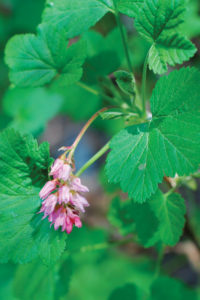Currant
GOOSEBERRY FAMILY
Wax Currant Ribes cereum
Sierra Currant syn. Pink Sierra Currant Ribes nevadense
Sticky Currant Ribes viscosissimum
Habitat & Elevation
Wax Currant: woods, thickets, rocky areas 5,000′ – 13,000′
Sierra Currant syn. Pink Sierra Currant: streambanks 3,000′ – 10,000′
Sticky Currant: forests and streambanks 5,000′ – 9,500′
Collection Berry: summer
![]()
Sierra Currant Ribes nevadense
Plant type Deciduous shrub
Size 3′ – 6’x3′ – 6′
Light Partial shade to shade
Water Regular
Zone 5 to 8
A beautiful, medium-sized deciduous shrub native to mountain ranges throughout California up to 10,000′. It has bright green, lobed leaves that grow up to 3″ wide, pale pink flowers that hang in 6″ long clusters, and small, blue fruits. The leaves and flowers emerge together from April to July, depending on elevation.
In its native habitat, Sierra Currant is easy to maintain. It tolerates both standing water and drought conditions. Use as a foundation plant in a shady spot, or mix with other shade-tolerant natives such as Giant Chain Fern (Woodwardia fimbriata), Thimbleberry (Rubus parviflorus), Western Columbine (Aquilegia formosa) and Dogwood (Cornus species).[20, 41]
Wax Currant Ribes cereum
Plant type Deciduous shrub
Size 6’x6′
Light Full sun to partial shade
Water Drought tolerant to moderate
Zone 5 to 8
Wax Currant is a mounding, deciduous shrub native to California mountains up to 4,500′ – 12,000′. Small clusters of white to light pink flowers emerge in June or July, followed by attractive, bright green, waxy leaves which are roundish with shallow lobes, growing up to 2″ wide. A profusion of scarlet, edible berries follow the flowers. In fall, foliage turns yellow to deep gold before dropping from the branches.
Wax Currant tolerates a variety of situations, either moist or dry, shaded or exposed. Planted in well-drained soil, it should require little maintenance.[20, 41]
![]()
FRESH/DRIED
Fresh and dried Wax Currants (Ribes cereum) were eaten as a preferred food by Hopi, Klamath, Montana, Okanagan, Paiute and Thompson Indians as well as many others. The Miwoks enjoyed Sierra Currants (Ribes nevadense) and the Montana Indians considered Sticky Currants (Ribes viscosissimum) a favorite food.[15]
TIP Blend with other berries or add to bread recipes.





